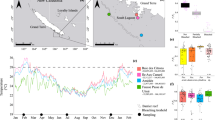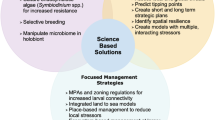Abstract
Scleractinian corals represent the main functional group in a coral reef ecosystem. So far, very few studies have ever reported how an in situ coral spectra changes with increasing water column purely in a natural environment. This paper reports the results of a unique field experiment wherein water column effects were observed over time on in situ hyperspectral signatures (over a continuous spectral range 400–1350 nm) of three live coral species from Gujarat coast of India. In situ hyperspectral measurements were taken with Analytical Spectral Devices (ASD) FieldSpec3 spectroradiometer having full spectral range of 350–2500 nm and spectral resolution of 3 nm (at 700 nm) and 10 nm (at 1400, 2100 nm). Three coral species, Favia favus, Goniopora planulata and Turbinaria peltata, were selected as case representatives for this study. In exposed condition, all three corals exhibit brown mode of coral reflectance with characteristic triple peaks at 575, 600 and 650 nm. It is observed that water column attenuates the original signature of corals by enhancing the spectral magnitude in the visible region and in inverse fashion in the infrared region. The first derivative spectra clearly bring out the sensitivity of 840-nm channel towards water column. The water column height at which the triple peak pattern gets obscured varies for the three coral species. The spectral reflectance of coral as a bottom substrate continues to remain strong between 700–720 and 1050–1080 nm even in marginally submerged condition.





Similar content being viewed by others
References
Andréfouët, S., Hochberg, E. J., Chevillon, C., Muller-Karger, F. E., Brock, J. C., & Hu, C. (2005). Multi-scale remote sensing of coral reefs. In R. L. Miller, C. E. DelCastillo, & B. A. McKee (Eds.), Remote sensing of coastal aquatic environments: Technologies, techniques and applications (pp. 297–315). Dordrecht: Springer.
Clark, C. D., Mumby, P. J., Chisholm, J. R. M., Jaubert, J., & Andréfouët, S. (2000). Spectral discrimination of coral mortality states following a severe bleaching event. International Journal of Remote Sensing, 21(11), 2321–2327.
Dekker, A. G., Brando, V. E., Anstee, J. M., Pinnel, N., Kutser, T., Hoogenboom, E. J., et al. (2001). Imaging spectrometry of water. In F. D. Van Der Meer & S. M. De Jong (Eds.), Imaging spectrometry: Basic principles and prospective applications (pp. 307–359). Dordrecht: Kluwer Academic Publishers.
Dove, S. G., Hoegh-Guldberg, O., & Ranganathan, S. (2001). Major colour patterns of reef-building corals are due to a family of GFP-like proteins. Coral Reefs, 19, 197–204.
Hedley, J. D., & Mumby, P. J. (2002). Biological and remote sensing perspectives of pigmentation in coral reef organisms. Advances in Marine Biology, 43, 277–317.
Hedley, J. D., Mumby, P. J., Joyce, K. E., & Phinn, S. R. (2004). Spectral unmixing of coral reef benthos under ideal conditions. Coral Reefs, 23, 60–73.
Hochberg, E. J., & Atkinson, M. J. (2000). Spectral discrimination of coral reef benthic communities. Coral Reefs, 19, 164–171.
Hochberg, E. J., & Atkinson, M. J. (2003). Capabilities of remote sensors to classify coral, algae and sand as pure and mixed spectra. Remote Sensing of Environment, 85, 174–189.
Hochberg, E. J., Atkinson, M. J., & Andréfouët, S. (2003). Spectral reflectance of coral reef bottom-types worldwide and implications for coral reef remote sensing. Remote Sensing of Environment, 85, 159–173.
Hochberg, E. J., Atkinson, M. J., Apprill, A., & Andréfouët, S. (2004). Spectral reflectance of coral. Coral Reefs, 23, 84–95.
Holden, H., & LeDrew, E. (1998). Spectral discrimination of healthy and non-healthy corals based on cluster analysis, principal components analysis and derivative spectroscopy. Remote Sensing of Environment, 65, 217–224.
Holden, H., & LeDrew, E. (1999). Spectral identification of coral reef features. International Journal of Remote Sensing, 20(13), 2545–2563.
Holden, H., & LeDrew, E. (2001). Effects of the water column on hyperspectral reflectance of submerged coral reef features. Bulletin of Marine Science, 69(2), 685–699.
Holden, H., & LeDrew, E. (2002). Measuring and modeling water column effects on hyperspectral reflectance in a coral reef environment. Remote Sensing of Environment, 81, 300–308.
Huen, W., & Zhang, Y. (2012). Spectral discrimination of coral species and habitats in Hong Kong. In Proceedings of the 12th international coral reef symposium. Cairns, Australia, 9–13 July, 2012.
Joyce, K. E., & Phinn, S. R. (2002). Bi-directional reflectance of corals. International Journal of Remote Sensing, 23(2), 389–394.
Joyce, K. E., & Phinn, S. R. (2003). Hyperspectral analysis of chlorophyll content and photosynthetic capacity of coral reef substrates. Limnology and Oceanography, 48(1, part 2), 489–496.
Kutser, T., Dekker, A. G., & Skirving, W. (2003). Modeling spectral discrimination of Great Barrier Reef benthic communities by remote sensing instruments. Limnology and Oceanography, 48(1, part 2), 497–510.
Leiper, I., Phinn, S. R., & Dekker, A. G. (2012). Spectral reflectance of coral reef benthos and substrate assemblages on Heron Reef, Australia. International Journal of Remote Sensing, 33(11–12), 3946–3965.
Levy, O., Dubinsky, Z., & Achituv, Y. (2003). Photobehavior of stony corals: Responses to light spectra and intensity. The Journal of Experimental Biology, 206, 4041–4049.
Lubin, D., Li, W., Dustan, P., Mazel, C. H., & Stamnes, K. (2001). Spectral signatures of coral reefs: Features from space. Remote Sensing of Environment, 75, 127–137.
Maritorena, S. (1996). Remote sensing of the water attenuation in coral reefs: A case study in French Polynesia. International Journal of Remote Sensing, 17(1), 155–166.
Maritorena, S., Morel, A., & Gentili, B. (1994). Diffuse reflectance of oceanic shallow waters: Influence of water depth and bottom albedo. Limnology and Oceanography, 39(7), 1689–1703.
Mazel, C. H. (1995). Spectral measurements of fluorescence emission in Caribbean cnidarians. Marine Ecology Progress Series, 120, 185–191.
Myers, M. R., Hardy, J. T., Mazel, C. H., & Dustan, P. (1999). Optical spectra and pigmentation of Caribbean reef corals and macroalgae. Coral Reefs, 18, 179–186.
Navalgund, R. R., Ajai, Bahuguna A., Ray, Chaudhury N., Bhattji, N. S., Madhupriya, N., Sharma, S., et al. (2010). Coral Reef Atlas of The World Vol. 1 Central Indian Ocean (p. 282). Ahmedabad: Space Applications Centre, (ISRO).
Patel, M. I. (1978). Generic diversity of scleractinians around Poshetra Point, Gulf of Kutch. Indian Journal of Marine Sciences, 7, 30–32.
Purkis, S. J. (2005). A “reef-up” approach to classifying coral habitats from IKONOS imagery. IEEE Transactions on Geoscience and Remote Sensing, 43(6), 1375–1390.
Ralph, P. J., Larkum, A. W. D., & Kuhl, M. (2007). Photobiology of endolithic microorganisms in living coral skeletons: 1. Pigmentation, reflectance and variable chlorophyll fluorescence analysis of endoliths in the massive corals Cyphastrea serailia, Porites lutea and Goniastrea australensis. Marine Biology, 152, 395–404.
Rundquist, D., Gitelson, A., Lawson, M., Keydan, G., Leavitt, B., Perk, R., et al. (2009). Proximal sensing of coral features: Spectral characterization of Siderastrea sidereal. GIScience and Remote Sensing, 46(2), 139–159.
Stambler, N. (2011). Zooxanthellae: The yellow symbionts inside animals. In Z. Dubinsky & N. Stambler (Eds.), Coral reefs: An ecosystem in transition (pp. 87–106). Dordrecht: Springer.
Torres-Pèrez, J. L., Guild, L. S., & Armstrong, R. A. (2012). Hyperspectral distinction of two Caribbean shallow water corals based on their pigments and corresponding reflectance. Remote Sensing, 4, 3813–3832.
Van Der Meer, F. D. (2001). Basic physics of spectrometry. In F. D. Van Der Meer & S. M. De Jong (Eds.), Imaging Spectrometry: Basic principles and prospective applications (pp. 6–16). Dordrecht: Kluwer Academic Publishers.
Venkataraman, K., & Satyanarayana, Ch. (2012). Coral identification manual (pp. 7–9). Kolkata: Zoological Survey of India.
Venkataraman, K., Satyanarayana, Ch., Alfred, J. R. B., & Wolstenholme, J. (2003). Handbook on hard corals of India (p. 266). Kolkata: Zoological Survey of India.
Acknowledgements
The authors are thankful to Director, Space Applications Centre (SAC), ISRO, and Deputy Director, Earth, Ocean, Atmosphere, Planetary Sciences and Applications Area (EPSA), SAC, for providing an opportunity to carry out this study under PRACRITI-Phase-II programme. The authors are thankful to Dr. Ch. Satyanarayana, Chief Coral Taxonomist from Zoological Survey of India, Kolkata, for authenticating the sampled coral species identification. The authors express their sincere thanks to the supporting team from Gujarat Ecological and Environment Education Research (GEER) Foundation, Gandhinagar, in realizing the in situ hyperspectral measurements. The authors thank Dr. Prakash Chauhan, Group Director, Biological and Planetary Sciences Group (BPSG), at SAC for his encouragement towards the study. The authors thank Dr. R. P. Singh, Head, Environment and Hydrology Division, SAC, for his valuable suggestions towards conducting the in situ experiment and manuscript preparation. The authors thank Prabakaran Ch., former Research Fellow at SAC, for his support in field data collection.
Author information
Authors and Affiliations
Corresponding author
Additional information
Publisher's Note
Springer Nature remains neutral with regard to jurisdictional claims in published maps and institutional affiliations.
About this article
Cite this article
Ray Chaudhury, N., Gujrati, A. & Murthy, T.V.R. Water Column Effects on In Situ Spectral Signatures of Coral Species from Gujarat Coast, India. J Indian Soc Remote Sens 47, 1577–1586 (2019). https://doi.org/10.1007/s12524-019-00992-w
Received:
Accepted:
Published:
Issue Date:
DOI: https://doi.org/10.1007/s12524-019-00992-w




